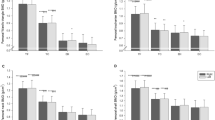Abstract
Summary
Professional jockeys are routinely exposed to high impact trauma and sustain fractures frequently. We found that jockeys restrict their caloric intake in order to maintain regulation weights, and that bone turnover is high. There are significant health and safety implications for the racing industry.
Introduction
Professional jockeys routinely sustain fractures from high impact falls. Jockeys maintain a low percentage body fat and a low body mass index (BMI) to achieve low weight targets in order to race. We evaluated dietary habits and bone metabolism in jockeys.
Methods
Bone mineral density (BMD) was measured in 27 male jockeys of the 144 jockeys licensed in Ireland. Fourteen (52%) had BMD T score below −1.0, of whom 12 consented to clinical review, nutritional survey, endocrine studies, and bone turnover markers (BTM). BTM were compared to age- and sex-matched controls (n = 16).
Results
BMI was 20.6 ± 1.7 kg/m2; previous fracture frequency was 3.2 ± 2.0 per rider. All had normal endocrine axes. The jockeys' diet as determined by a 7-day dietary recall was deficient in energy, calcium, and vitamin D intake. Compared with the control group, the jockey group had evidence of increased bone turnover.
Conclusions
A substantial proportion of the professional jockeys in Ireland have low–normal BMD, low BMI, and high bone turnover that may result from weight and dietary restrictions. These factors seem to have a deleterious effect on their bone health and predispose the jockeys to a high fracture risk that should be remediated.

Similar content being viewed by others
References
The Turf Club. http://www.turfclub.ie/site/
Turner M, McCrory P, Halley W (2002) Injuries in professional horse racing in Great Britain and the Republic of Ireland during 1992–2000. Br J Sports Med 36:403–409
McCrory P, Turner M, LeMasson B et al (2006) An analysis of injuries resulting from professional horse racing in France during 1991–2001: a comparison with injuries resulting from professional horse racing in Great Britain during 1992–2001. Br J Sports Med 40:614–618
Balendra G, Turner M, McCrory P et al (2007) Injuries in amateur horse racing (point to point racing) in Great Britain and Ireland during 1993–2006. Br J Sports Med 41:162–166
Yim VWT, Yeung JHH, Mak PSK et al (2007) Five year analysis of Jockey Club horse-related injuries presenting to a trauma centre in Hong Kong. Injury 38:98–103
McGoldrick A (2004) Presentation to the safety committee. The Turf Club. http://www.turfclub.ie/site/index.php?option=com_wrapper&Itemid=39
Frost HM (1983) Bone histomorphometry: analysis of trabecular bone dynamics. In: Recker RR (ed) Bone histomorphometry: techniques and interpretation. CRC, Boca Raton, pp 109–131 (2002)
Dawson-Hughes B, Heaney RP, Holick MF et al (2005) Estimates of optimal vitamin D status. Osteoporos Int 16:713–716
Mackey DC, Li-Yung Lui L-Y et al (2007) High-trauma fractures and low bone mineral density in older women and men. JAMA 298:2381–2388
McKenna MJ (1992) Differences of vitamin D status between various countries in young adults and the elderly. Amer J Med 93:69–77
McKenna MJ, Freaney R (1998) Secondary hyperparathyroidism in the elderly: means to defining hypovitaminosis D. Osteoporos Int 8(Suppl 2):S3–S6
Szulc P, Delmas PD (2008) Biochemical markers of bone turnover: potential use in the investigation and management of postmenopausal osteoporosis. Osteoporos Int 19:1683–1704
Chapuy MC, Schott AM, Garnero P, Hans D, Delmas PD, Meunier PJ (1996) Healthy elderly French women living at home have secondary hyperparathyroidism and high bone turnover in winter. EPIDOS Study Group. J Clin Endocrinol Metab 81:1129–1133
Holick MF, Siris ES, Binkley N, Beard MK, Khan A, Katzer JT, Petruschke RA, Chen E, de Papp AE (2005) Prevalence of vitamin D inadequacy among postmenopausal North American women receiving osteoporosis therapy. J Clin Endocrinol Metab 90:3215–3224
Malabanan A, Veronikis IE, Holick MF (1998) Redefining vitamin D insufficiency. Lancet 351:805–806
McKenna MJ, Freaney R, Byrne P, McBrinn Y, Murray B, Kelly M, Donne B, O'Brien M (1995) Safety and efficacy of increasing wintertime vitamin D and calcium intake by milk fortification. Q J Med 8:895–898
Cashman KD, Hill TR, Lucey AJ, Taylor N, Seamans KM, Muldowney S, Fitzgerald AP, Flynn A, Barnes MS, Horigan G, Bonham MP, Duffy EM, Strain JJ, Wallace JM, Kiely M (2008) Estimation of the dietary requirement for vitamin D in healthy adults. Am J Clin Nutr 88:1535–1542
Warren MP, Brooks-Gunn J, Fox RP et al (2002) Osteopenia in exercise-associated amenorrhea using ballet dancers as a model: a longitudinal study. J Clin Endocrinol Metab 87:3162–3168
Andreoli A, Monteleone M, Van Loan M et al (2001) Effects of different sports on bone density and muscle mass in highly trained athletes. Med Sci Sports Exerc 33:507–511
Nordstorm A, Olsson T, Nordstorm P (2006) Sustained benefits from previous physical activity on bone mineral density in males. J Clin Endocrinol Metab 91:2600–2604
Rector RS, Rogers R, Ruebel M et al (2008) Participation in road cycling vs running is associated with lower bone mineral density in men. Metabolism 57:226–232
Moore JM, Timperio AF, Crawford DA et al (2002) Weight management and weight loss strategies of professional jockeys. Int J Sport Nut Exercise Metab 12:1–13
Leyon MA, Wall C (2002) New Zealand jockey's dietary habits and their potential impact on health. Int J Sport Nut Exercise Metab 12:220–237
Villareal DT, Fontana L, Weiss EP et al (2006) Bone mineral density response to caloric restriction-induced weight loss or exercise-induced weight loss. Arch Intern Med 166:2502–2510
Conflicts of interest
None.
Author information
Authors and Affiliations
Corresponding author
Rights and permissions
About this article
Cite this article
Waldron-Lynch, F., Murray, B.F., Brady, J.J. et al. High bone turnover in Irish professional jockeys. Osteoporos Int 21, 521–525 (2010). https://doi.org/10.1007/s00198-009-0887-0
Received:
Accepted:
Published:
Issue Date:
DOI: https://doi.org/10.1007/s00198-009-0887-0




